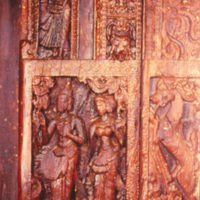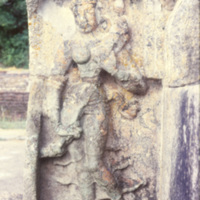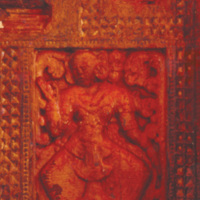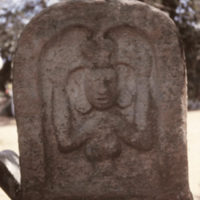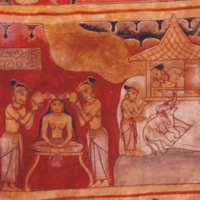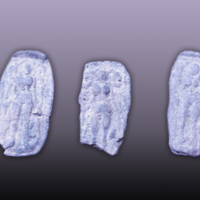Main Menu
AORC Libraries
Browse Items in Women in Sri Lankan Sculpture and Painting (166 total)
Guardian Deities
Description: The idea of the joint role of male and female as guardian deities is conveyed in this wood-carving at the Uda Aludeniya temple near Gampola, Sri Lanka. The couple at the bottom of the door jambs here are not represented as nagas (cobras), but there seems to be a close parallel with a stone sculpture seen at Kurunegala, Sri Lanka. Two females bearing chamaras or fly whisks are carved on two upper panels of the door jambs. They are perhaps attendant goddesses. A date in the 14th century A.D. has been suggested by scholars on stylistic grounds.
Contributor: Co-Author: Seneviratna, Harsha
Collection: Women in Sri Lankan Sculpture and Painting
Tags: AISLS, Attendant Goddesses, ICES, PDWESLSP
Female guardians
Description: On either side of the steps leading to the main building among the ruins at Yapahuva, Sri Lanka, are carved panels, with single female guardians. Although not naginis (female cobras), their shawls twirl up like cobra hoods. They carry pots of plenty symbolizing prosperity and good luck. The buildings at Yapahuva, Sri Lanka are attributed to the 13th century A.D. by art historians.
Contributor: Co-Author: Seneviratna, Harsha
Collection: Women in Sri Lankan Sculpture and Painting
Tags: AISLS, Attendant Goddesses, ICES, PDWESLSP
Carved Apsaras
Description: On the jambs of the entrance doorway at the top of the stairway at Yapahuva, Sri Lanka are carved panels of apsaras or divine maidens, carrying musical instruments, expressing devotion or bhakti. The buildings at Yapahuva, Sri Lanka, are attributed to the 13th century A.D. by historians.
Contributor: Co-Author: Seneviratna, Harsha
Collection: Women in Sri Lankan Sculpture and Painting
Tags: AISLS, Attendant Goddesses, ICES, PDWESLSP
Female dancers as guardians of temples
Description: Female door guardians or dvarapalikas in dance poses emphasize the devotional stance of these goddesses. This carved relief is at the bottom of one of the wooden door jambs at the entrance to the shrine of the main Buddhist temple at Vakirigala in the Kegalle district, Sri Lanka. Stylistically this sculpture belongs to the Kandyan period (16th-18th century A.D.).
Contributor: Co-Author: Seneviratna, Harsha
Collection: Women in Sri Lankan Sculpture and Painting
Tags: AISLS, Attendant Goddesses, ICES, PDWESLSP
Women as door guardians
Description: This dvarapalika (female door guardian), carved at the entrance of a Buddhist religious building was considered to be auspicious. Attributed to the Kandyan period (16th-18th century A.D.), this stone relief was found during excavations in the Kandy Cultural Project area and can be seen at the Cultural Triangle Project Office in Kandy, Sri Lanka.
Contributor: Co-Author: Seneviratna, Harsha
Collection: Women in Sri Lankan Sculpture and Painting
Earth goddesses
Description: These two female busts are identified as the earth goddesses or polovamahikanthava who acts as guardians. They seem to rise out of the earth from their placement at the entrance to a Buddhist temple. This guardstone, is one of two found at the entrance to the precincts of the Dippitiya Vihare in the Kegalle district, Sri Lanka. The temple is dated in the Kandyan period (16th-18th century A.D.).
Contributor: Co-Author: Seneviratna, Harsha
Collection: Women in Sri Lankan Sculpture and Painting
Tags: AISLS, Attendant Goddesses, ICES, PDWESLSP
Earth goddess
Description: This painting represents the polovamahikanthava, or earth goddess, rising out of the earth as witness to the Buddha's former deeds. The personification of the earth as goddess in temple art is a popular device in the Kandyan period (16th-18th century A.D.). This painting from Degaldoruva, Kandy, Sri Lanka, is a symbolic expression of the earth rising up to bear witness to the Buddha’s deeds in earlier times.
Contributor: Co-Author: Seneviratna, Harsha
Collection: Women in Sri Lankan Sculpture and Painting
Tags: AISLS, Attendant Goddesses, ICES, PDWESLSP
Goddess Lakshmi or Shri
Description: Goddess Lakshmi or Shri in the art of early Sri Lanka- Common to both Buddhist and Hindu art in India as well as Sri Lanka is Lakshmi or Shri, the goddess of prosperity. The most popular motif in which she figures is that of ‘Gajalaksmi’ in which the goddess sits or stands on a lotus while two elephants holding pots pour water over her head. The earliest appearance of the Gajalaksmi symbol in India is in the Buddhist sculpture at Bharhut and later Sanchi. This has even led to the view that the motif is symbolic of the birth of the Bodhisattva.
Contributor: Co-Author: Seneviratna, Harsha
Collection: Women in Sri Lankan Sculpture and Painting
Queen Mahamaya, bathed by attendants.
Description: This painting, depicting the bathing of queen Maya, is reminiscent of the Gajalaksmi symbol in which the goddess sits or stands on a lotus while two elephants holding pots pour water over her head. It was found among the paintings at Dambulla, Sri Lanka, that show Queen Maya in scenes associated with the Bodhisattva's birth.
Contributor: Co-Author: Seneviratna, Harsha
Collection: Women in Sri Lankan Sculpture and Painting
Copper plaques with the Gajalakshmi symbol
Description: These copper plaques with the Gajalaksmi symbol of prosperity are known to have been used as currency in Sri Lanka during the early centuries of the Christian era. Several examples are seen among the exhibits of the National Museums of Colombo and Kandy, Sri Lanka.
Contributor: Co-Author: Seneviratna, Harsha
Collection: Women in Sri Lankan Sculpture and Painting



